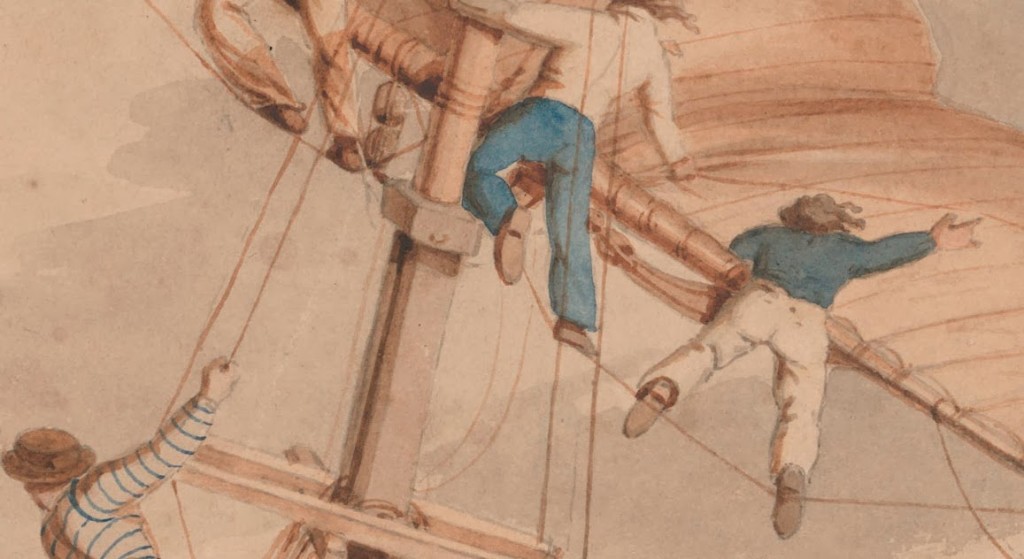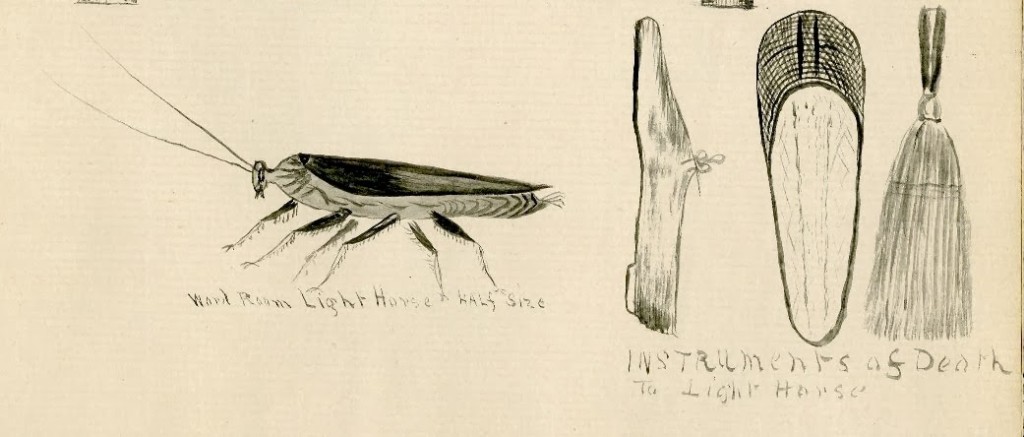Pick up any modern book about the age of sail, and you’re likely to read that sailors never wore shoes on board ship. As the reasoning goes, the men had much better traction on a wet deck and aloft in the rigging if they dispensed with their slippery, leather-soled shoes. While salt water adversely affects leather, and the thin calf-skin shoes favored by the U.S. Navy might have fallen to pieces with frequent wetting and the stress of work, this was just another inconvenience of life at sea (as would frost-bitten feet be if one were to run about bare-footed in the North Atlantic at most seasons of the year). Sailor Frederick Harlow offered his wisdom as to why shoes were necessary on board ship:
“If you think its fun to run aloft barefooted, with only a ratline to stand on, just try it. After running up six or eight ratlines you begin to hunt for a soft place to stand on. Your feet, which have become parboiled from standing in water from the last heavy shower, are very tender. The ratlines are made fast with a clove-hitch around the shrouds and afford a better place than the middle of the rope and so you climb, using your hands to relieve your weight, with your knees pressing against the ratline above to help your hands and your toes at times against the clove-hitch on the shroud. It is vastly different from going up the back stairs at home in your stocking feet.”1

Dr. William Barton, the U.S. Navy’s tireless reformer, suggested that sailors were quite fond of their shoes and were loath to take them off. When he ordered the men to wash the decks, “the officer of the deck should see that every man takes off his shoes and stockings, and rolls up his trowsers. Those who have good strong boots may be exempted from this regulation. Perhaps it would be advisable for the purser to lay in among his slops, a sufficient number of boots of this description, or such as are known by the name of ditchers’ boots.”2 Barton, of course, was not the first to think of this, and not surprisingly, seamen often had access to boots. New York merchant David Lyon delivered 60 pairs of “strong boots” to Purser James Wilson at New York in January 1810, presumably for the use of gunboat crews in the harbor.3 In 1816, Lyon offered “Seamens’ Boots” to the navy, besides an assortment of lined and bound shoes. The boots didn’t come cheap however, costing the navy $5.50 each wholesale.4 The cost alone may have precluded the widespread use of boots among seamen. In fact, the evidence for shoes on board ship is overwhelming.
Dr. Amos Evans, USS Constitution’s medical officer, recounts a story in which one seaman’s refusal to part with his shoes almost cost him his life:
At 3 P.M. a sailor fell overboard out of the main chains. The topsail was instantly backed and the stern boat lowerd down. The man being (fortunately) an expert swimmer, kept on top of the water, and was pickd up about 200 yards astern. He said he could have taken off his shoes, but did not wish to lose them! The blood however appeared to have forsaken his cheeks. The tenure of a sailor’s existence is certainly more precarious than any other man’s, a soldier’s not excepted. Who would not be a sailor? I, for one.5
When shoes cost nearly two dollars, or 1/6th of an able seaman’s monthly wage, it is easy to understand why he hung onto them at all costs!
Further evidence of regular shoe wearing can be found by examining the frequency with which seamen bought shoes from the purser. Of the 398 men who appear in Constitution’s December 1803 slop book, 205, or slightly more than 50 percent, purchased shoes that month.6 Seamen on the brig Syren in 1804 and 1805 bought a pair of shoes every month or every other month during the 9 months of the pay book.7 On gunboat No. 6, stationed at New York, 20 men purchased 59 pairs of shoes over the course of several months, or nearly three pairs per man. Only one man did not buy any shoes at all, while several bought as many as five, six, or seven pairs!8 If we rule out a penchant for collecting shoes among the men, it seems likely they were replacing rapidly decomposing footwear. And if the shoes fell apart frequently, it would seem they actually wore their shoes all the time, insuring that their useful life in shipboard conditions was not much more than a month or two.
Unlike other clothing, there never seemed to be a pattern shoe for the navy. In fact, receipts and requisitions imply the navy bought nearly any kind of cheap shoe it could acquire. In April 1813, a merchant delivered a barrel of “mens wax & calf shoes” to the Boston Navy Yard.9 These had probably been produced in Lynn or one of the surrounding towns, the epicenter of early nineteenth century shoe production in New England. Civilians commonly wore calfskin shoes, but the military frequently required something stouter. One merchant offered somewhat stronger “good Cow hyde Shoes” in 1816.10 Another merchant had shoes of two different qualities available: “wax shoes or grane [grain, i.e. rough side of the leather out] shoes, the grane with the quarters lin’d with muslin at one dollar and five cents per pair.”11
Navy Agent James Beatty acquired from Baltimore merchant Thomas Sheppard 300 pairs of shoes, including 150 “Baltimore make fine” at $1.60 each, and 150 “Penitentary [sic] make coarse,” an example of using convict labor for the war effort.12 The brig Syren received a shipment of “150 pair first quality Men’s English Shoes” in 1813.13 This proportion of coarse to fine shoes is common and is frequently repeated in the records, suggesting that although seamen may have known the coarse variety to be more serviceable, they really preferred the more fashionable and comfortable “fine” shoes instead. David Lyon, who in 1819 had supplied the New York station with shoes for “eleven to thirteen years past,” offered both “narrow strap leather lined” shoes as well as “muslin lined” versions.14 Shoemaker Daniel Kilburn of Orange, New York offered shoes “such as furnished for the use of the Army of the United States for years past with such lighter ones as may be wanted for the use of the Navy.”15 The fact that the navy wanted light shoes suggests the truth in the statement made by one officer, that “[sailors] are… fond of wearing shoes which are made exactly after the fashion of women’s pumps.”16 Caricaturists loved to depict seamen in dainty pumps, the thin toes often poking from beneath the cuff of voluminous trousers.
Shoe uppers were joined using a butt stitch (round closed) sewn with linen thread. Most shoes had sewn soles as well, but shoemakers perfected the process of joining soles to uppers with pegs by about 1811.17 This innovation allowed manufactures to increase production, which in turn made the shoes cheaper. Pegged shoes, however, had their disadvantages. They were often made of “such wretched materials that after being wet in salt water and worn two or three times up and down the rigging, they spread out so as to cover as much of the deck as a shot box would.”18

Fine or coarse, greased or not, a good pair of shoes was as important to the man-of-war’s man as a monkey jacket or a knife — indispensable marks of the true sailor. Sailors attempted to prolong the life of their shoes any way they could. Liberally coating footwear with tallow or other easily accessible grease made them more supple and water resistant, but had drawbacks. Constitution‘s seamen discovered this in a storm at sea: “Neptune, when he gets at it, is a real leveller. Some who had greased their shoes to keep them water proof, found it easier lying than standing, and were called full often to pick themselves from the wet deck, only to try their skill at diving again.”19
1 Frederick Pease Harlow, The Making of a Sailor; or Sea Life Aboard a Yankee Square-Rigger (New York: Dover Publications, Inc., 1988), 169.
2 William P.C. Barton, A Treatise Containing a Plan for the Internal Organization and Government of Marine Hospitals in the United States (Philadelphia: Printed for the author, 1814), 231.
3 James R. Wilson receipt from David Lyon, January 1, 1810, in Fourth Auditor Settled Accounts, Alphabetical Series, RG 217, Box 2880, NARA.
4 David Lyon to Navy Board of Commissioners, 2 April 1816, in Proposals, Reports, and Estimates for Supplies and Equipment, 1814-1833, RG 45, E 328, vol.4. NARA. A letter of support from Navy Agent John Bullus notes that Mr. Lyon “has for a length of time past, been in the habit of furnishing Boots & Shoes for the public vessels on this station, and for the Lakes.”
5 Amos Evans, Journal Kept on Board the Frigate Constitution, 1812 Reprint (Lincoln, MA: William D. Sawtell, 1967), p. 166.
6 Slop Book, Frigate Constitution, “Pay Roll USS Constitution 1803-1828,” Microfilm T829, Roll 95, NARA.
7 Gwinn Harris, “William Dixon, Seaman In Acct, with US Brig Siren,” “Charles Robinson, Seaman In Acct, with US Brig Siren,”, and “James Passgrove, Seaman In Acct, with US Brig Siren,” in Fourth Auditor Settled Accounts, Alphabetical Series, RG 217, Box 947, NARA.
8 James R. Wilson, “Account of Slop Clothing issued to Crews of the United States Vessels composing the Flotilla at New York, under the command of Commodore J. Rodgers, by J.R. Wilson, Purser,” no date, in Fourth Auditor Settled Accounts, Alphabetical Series, RG 217, Box 2880, NARA.
9 Amos Binney voucher to Parker and Tarbell, April 23, 1813, in Fourth Auditor Settled Accounts, Alphabetical Series, RG 217, Box 39, NARA.
10 Paul Buswell to Navy Board of Commissioners, 20 March 1816, in Proposals, Reports, and Estimates for Supplies and Equipment, 1814-1833, RG 45, E 328, vol.4. NARA.
11 J. and S. Condit to Navy Board of Commissioners, 25 March 1816, in Proposals, Reports, and Estimates for Supplies and Equipment, 1814-1833, RG 45, E 328, vol.4. NARA.
12 Voucher to James Beatty, 13 March 1813, in Fourth Auditor Settled Accounts, Alphabetical Series, RG 217, NARA. The Charlestown Navy Yard received shipments of nails, bolts , and other iron work made by prisoners at the State Prison in Boston. As late as the 1830s, the US Navy was still buying shoes made in state prisons.
13 Amos Binney voucher to Archibald Hill, 24 Jan 1814, in Fourth Auditor Settled Accounts, Alphabetical Series, RG 217, Box 39, NARA.
14 David Lyon to Navy Board of Commissioners, 24 Feb. 1819, in Proposals, Reports, and Estimates for Supplies and Equipment, 1814-1833, RG 45, E 328, vol.4. NARA.
15 Daniel Kilburn to the Board of Navy Commissioners, 18 March 1816, in Proposals, Reports, and Estimates for Supplies and Equipment, 1814-1833, RG 45, E 328, vol.4. NARA.
16 Anonymous, “Diary Kept on Board HMS Gibraltar, 1811,” in Brian Lavery, ed., Shipboard Life and Organization, 1731-1815 (Aldershot, England: Ashgate Publishing Ltd.:1998), 461-462.
17 David R. Meyer, The Roots of American Industrialization (JHU Press: 2003), 231.
18 William McNally, Evils and Abuses (Cassidy and March: 1839), 30.
19 Moses Smith, Naval Scenes from the Last War, or Three Years on Board the Frigate Constitution and the Adams; including the Capture of the Guerriere (Gleason’s Publishing Hall, Boston: 1846), 10.
The Author(s)
Matthew Brenckle
Research Historian, USS Constitution Museum
Matthew Brenckle was the Research Historian at the USS Constitution Museum from 2006 to 2016.